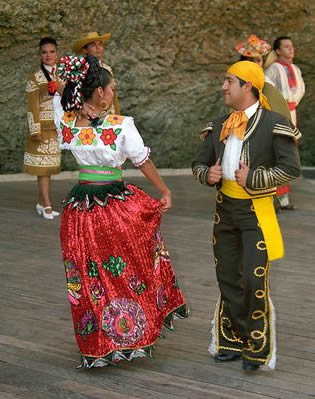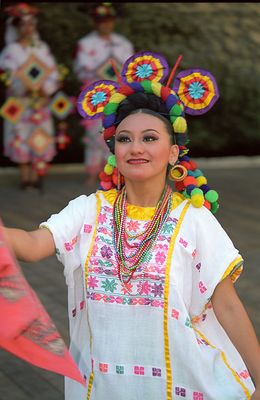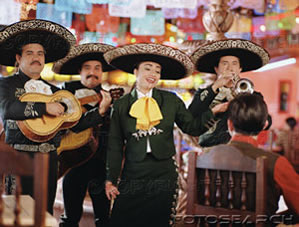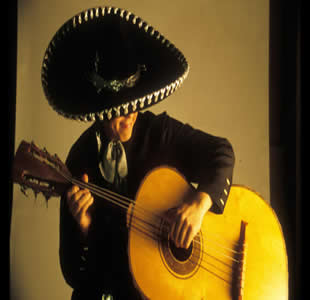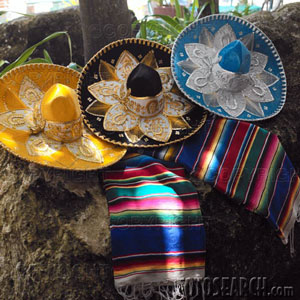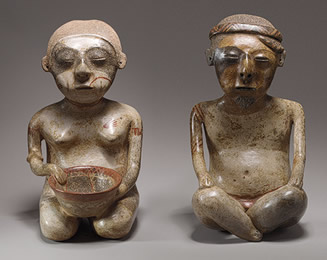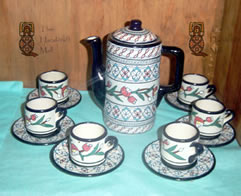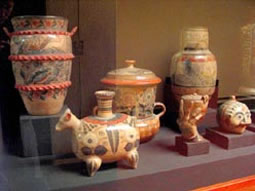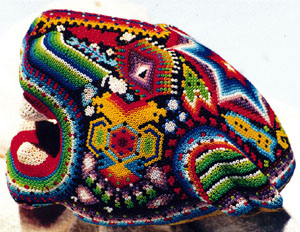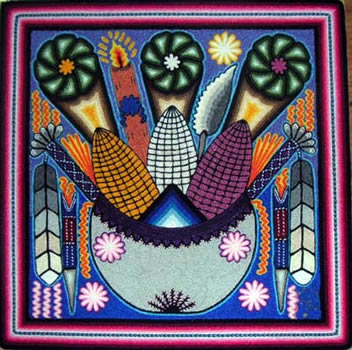A Taste of Mexican Culture
Folkloric Dances
Folkloric dance is not only the oldest form of dance, it is also the basis of all other dance forms. Mexican people have always used dance for communicating their emotions through rhythm and movement.
Folk dancing is a type of traditional, communal dancing, passed down from generation to generation in a social or recreational atmosphere.
|
- Folk dance uses traditional costumes and accessories which aids in preserving the link to cultural heritage.
- The types of dances include war dances, contest dances, courtship and wedding dances, holyday and religion dances and dances for fun of movement alone.
|
|
Mariachi Bands
About the music
Mariachi music is concidered the soul and feelings of a town. Through different songs, people narrates true stories of love and tragedy that have happened in small towns and cities accross Mexico. Mariachis often help celebrate the great moments in the lives of the Mexican people. With the serenata (serenade), the Mariachi participates in the rite of courtship. In a society where the young members of opposite sexes were kept apart, the serenata was a means of communication by which a man could send a message of love to the woman of his hearth. In many areas of Mexico, it is not unusual to be awakened by the sound of Las Mananitas, the traditional song for saints days or birthdays. The Mariachi is usually positioned strategically on the street beneath the window of the festejada, but the sound of its music echoes through the whole neighborhood. Mariachis are also commonly hired for Baptisms, Weddings, Patriotic Holidays, and even funerals. It is not unusual for the deceased to leave a list of favorite songs to be sung beside the grave at burial.
Mariachi Singer |
|
Traditional Mariachi Hats |
|
- The Mariachi's traditional outfit consists of a suit, is usually a dark color with tight fitting trousers trimmed down the sides with a double row of gold or silver buttons. A white shirt and folded tie is also worn.
- The large hat or "sombrero" finished by hand with colored threads and sequins completes the outfit.
- Traditional instruments include a guitar, trumpets, violins, and a guitarron.
|
|
Ceramic Art
Since the appearance of the Olmec culture, considered to be the "mother of the Mesoamerican cultures", ceramics took a prevailing place in the lives of the Mexican people. The earthenware vessels, anthropomorphic figures, and various types of utensils found in the archeological ruins of the ancient Olmec cities of ElTajin, San Lorenzo, La Venta and Tres Zapotes, suggest the techniques used in their ceramics: the use of clay, the knowledge of some primitive firing techniques, their means of coloring and painting designs.
The ancient techniques employed to make ceramics are still used today, mostly in the rural parts of Mexico. It is curious how these groups were able to preserve their artistic techniques -coil building, open firing, natural pigments- and yet they lost their original language and their religion.
Some Mexican creators have implemented new forms and new designs for typical Mexican artwork, such as ceramic eggs from which little frogs are born, lizards and other little animals; glass and ceramis twisters; key chains with eclipses; masks with a pre-Hispanic or oriental morif; dish sets with images of Tamayo or Rivera; tiles with geometrical figures, etc.
The Huichol Beaded and Yarn Art
The huichol indians of the Sierra Madre in Mexico are concidered a real treasure
While many native people in the Western Hemisphere have been absorbed into the mainstream of the modern world, the Huichol Indians, who live in a secluded part of Mexico, have maintained their traditional ways. For centuries, hidden away and protected by natural barriers of the Sierra Madre mountains, the Huicholes have survived, preserving their unique culture, religion and art.
Huichol Sacred Art
The Huicholes say there is a mirror between our hearts and everything in the universe. One of the ways they develop and maintain that connection is by making art-yarn paintings, beaded, woven, and embroidered work and rattles. Using age-old designs, Huichol sacred art makes the unseen world of the Ancient Ones visible; preserving the life of the tradition, which serves to maintain the life of the earth.
|
|
|
Most of the Huichol art consists of yarn paintings and beaded art. The beaded art is made by ovelaying carved wood shapes or gourds in the case of ceremonial bowls with a beeswax and pine resin mixture; then placing the beads on the sticky base, by hand, one by one until all of the patterns take form and resolve into a complete whole. |
| |
|
The Huichol believe themselves to be "mirrors of the gods" and try to reflect a sacred vision of the world both physically and spiritually. It is believed that the deities teach the Huicholes a variety of techniques they may use to influence the elements and maintain the delicate balance between life and death, sickness and health, abundance and misfortune. These techniques include ritual fasting, pilgrimages to sacred places, different forms of purification, dream interpretation, and the ceremonial use of Peyote. Peyote cactus is much revered by the Huichol, a veritable gift from the Gods. Through the use of peyote, the Huichol create the elaborate designs used in their artwork
|
|
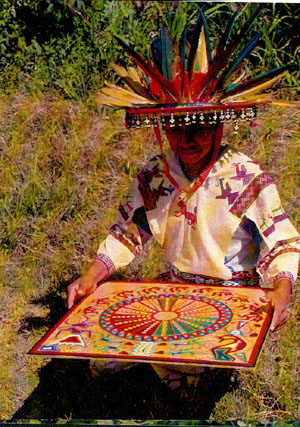 |
Huichol yarn paintings are created from the visions and dreams of the artist. They bring alive the world of Huichol shamanism and the gods and goddesses of creation, Grandfather Fire, Elder Brother Deer, Grandmother Growth and Grandmother Eagle, among others. The hidden world of Huichol shamanic tradition is revealed through these exquisite visions. The yarn paintings are made on large wooden squares that are covered first with beeswax. Then individual strands of multi-colored yarn are skillfully pressed into the wax. Integrate pattern of symbol and color are presented in these spectacular pieces.
Huichol art is an extension of the deep religious feelings that every Huichol acquires through participation in their traditional way of life. From the time they are children, they learn how to communicate with the spirit world through symbols and rituals.
The Huicholes teach us that man must be a steward of the Earth. He must feel in his heart the pain of the wounded animal or the crushed blade of grass because all souls are linked. The universal life force flows through all nature's creations. When man destroys nature, he destroys the finest part of his own being. |
The wisdom and rich cultural heritage of the Huichol is indeed the true treasure of the Sierra Madre of Mexico.
Home
Last updated March 8, 2006 by Maria Estrada
